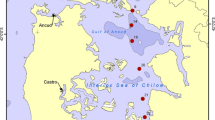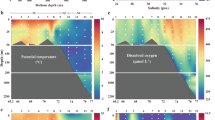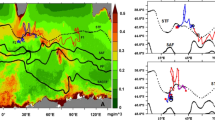Abstract
Nitrous oxide (N2O) distribution patterns in the Bering Sea basin (BSB) and Indian Sector of the Southern Ocean (ISSO) were described and compared. In both sites, the waters were divided into four layers: surface layer, subsurface layer, N2O maximum layer, and deep water. Simulations were made to find out the most important factors that regulate the N2O distribution patterns in different layers of both sites. The results showed that in the surface water, N2O was more understaturated in the ISSO than the BSB. This phenomenon in the surface water of ISSO may result from ice melt water intrusion and northeastward transport of the Antarctic surface water. Results of the rough estimation of air-sea fluxes during the expedition were (−0.34±0.07)–(−0.64±0.13) μmol/(m2·d) and (−1.47±0.42)–(−1.77±0.51) μmol/(m2·d) for the BSB and the ISSO, respectively. Strongly stratified surface layer and temperature minimum layer restricted exchange across the thermocline. The N2O maximum existed in higher concentration and deeper in the BSB than the ISSO, but their contribution to the upper layer by eddy diffusions was negligible. In deep waters, a concentration difference of 5 nmol/L N2O between these two sites was found, which suggested that N2O production occurred during thermohaline circulation. N2O may be a useful tracer to study important large-scale hydrographic processes.
Similar content being viewed by others
References
Bange H W. 2006. New directions: The importance of oceanic nitrous oxide emissions. Atmos Environ, 40(1): 198–199
Bange H W, Andreae M O. 1999. Nitrous oxide in the deep waters of the world’s oceans. Global Biogeochemi Cycles, 13(4): 1127–1135
Bouwman A F, Van der Hoek K W, Olivier J G J. 1995. Uncertainties in the global source distribution of nitrous oxide. J Geophys Res, 100(D2): 2785–2800
Broecker W S, Peng T H, Beng Z. 1982. Tracers in the Sea. A publication of Lamont-Doherty Geological Observatory, Columbia University. Palisades, New York: Eldigio Press, 690
Butler J H, Elkins J W. 1991. An automated technique for the measurement of dissolved N2O in natural waters. Mar Chem, 34(1): 47–61
Butler J, Elkins J, Thompson T, et al. 1989. Tropospheric and dissolved N2O of the West Pacific and East Indian Oceans during the El Nino southern oscillation event of 1987. J Geophys Res, 94(D12): 14865–14877
Carter L, McCave I, Williams M J M. 2008. Chapter 4: Circulation and water masses of the Southern Ocean: A review. In: Florindo F, Siegert M, eds. Developments in Earth and Environmental Sci ences. Vol 8. The Netherlands: Elsevier, 85–114
Chaigneau A, Morrow R A, Rintoul S R. 2004. Seasonal and interannual evolution of the mixed layer in the Antarctic Zone south of Tasmania. Deep-Sea Res Pt I, 51(12): 2047–2072
Charpentier J, Farias L, Yoshida N, et al. 2007. Nitrous oxide distribution and its origin in the central and eastern South Pacific Subtropical Gyre. Biogeosciences, 4(5): 729–741
Chen Liqi, Zhan Liyang, Xu Suqing, et al. 2012. Multiple processes affecting surface seawater N2O saturation anomalies in tropical oceans and Prydz Bay, Antarctica. Adv Polar Sci, 23: 89–94
Cline J D, Wisegarver D P, Kelly-Hansen K. 1987. Nitrous oxide and vertical mixing in the equatorial Pacific during the 1982–1983 El Niño. Deep-Sea Res Pt I, 34(5): 857–873
Codispoti L A, Christensen J P. 1985. Nitrification, denitrification and nitrous oxide cycling in the eastern tropical South Pacific Ocean. Mar Chem, 16(4): 277–300
Cohen Y, Gordon L I. 1978. Nitrous oxide in the oxygen minimum of the eastern tropical North Pacific: Evidence for its consumption during denitrification and possible mechanisms for its production. Deep-Sea Res, 25(6): 509–524
Cohen Y, Gordon L I. 1979. Nitrous oxide production in the ocean. J Geophys Res, 84(C1): 347–353
Craig H, Gordon L I. 1963. Nitrous oxide in the ocean and the marine atmosphere. Geochim Cosmochim Acta, 27(9): 949–955
De Wilde H P J, Helder W. 1997. Nitrous oxide in the Somali Basin: the role of upwelling. Deep-Sea Res Pt II, 44(6): 1319–1340
Flückiger J, Dällenbach A, Blunier T, et al. 1999. Variations in atmospheric N2O concentration during abrupt climatic changes. Science, 285(5425): 227–230
Freing A, Wallace D W R, Tanhua T, et al. 2009. North Atlantic production of nitrous oxide in the context of changing atmospheric levels. Global Biogeochemi Cycles, 23: GB4015, doi: 10.1029/2009GB003472
Goreau T J, Kaplan W A, Wofsy S C, et al. 1980. Production of NO2 - and N2O by nitrifying bacteria at reduced concentrations of oxygen. Appl Environ Microb, 40(3): 526–532
Hahn J. 1974. The North Atlantic Ocean as a source of atmospheric N2O. Tellus, 26(1–2): 160–168
Hahn J, Thrush B A, Nash T. 1979. The cycle of atmospheric nitrous oxide. Royal Society of London Philosophical Transactions Series A, Mathematical and Physical Sciences, 290(1376): 495–503
Hirota A, Ijiri A, Komatsu D D, et al. 2009. Enrichment of nitrous oxide in the water columns in the area of the Bering and Chukchi Seas. Mar Chem, 116(1): 47–53
Ho D T, Law C S, Smith M J, et al. 2006. Measurements of air-sea gas exchange at high wind speeds in the Southern Ocean: Implications for global parameterizations. Geophys Res Lett, 33: L16611, doi: 10.1029/2006GL026817
Junge C, Hahn J. 1971. N2O measurements in the North Atlantic. J Geophys Res, 76(33): 8143–8146
Khalil M A K, Rasmussen R A, Shearer M J. 2002. Atmospheric nitrous oxide: patterns of global change during recent decades and centuries. Chemosphere, 47(8): 807–821
Kitidis V, Upstill-Goddard R C, Anderson L G. 2010. Methane and nitrous oxide in surface water along the North-West Passage, Arctic Ocean. Marine Chemistry, 121(1): 80–86
Law C S, Ling R D. 2001. Nitrous oxide flux and response to increased iron availability in the Antarctic Circumpolar Current. Deep-Sea Res Pt II, 48(11): 2509–2527
Li Y H, Peng T H, Broecker W S, et al. 1984. The average vertical mixing coefficient for the oceanic thermocline. Tellus B, 36(3): 212–217
Luchin V A, Menovshchikov V A, Lavrentiev V M, et al. 1999. Thermohaline structure and water masses in the Bering Sea. In: Loughlin T R, Ohtanni K, eds. Dynamics of the Bering Sea. Fairbanks, Alaska: University of Alaska Sea Grant, 61–91
Murty T S, Flather R A, Henry R F, et al. 2001. Sub ice-shelf circulatio and processes. Coast Eng, 41(13): 40
Najjar R G, Sarmiento J L, Toggweiler J. 1992. Downward transport and fate of organic matter in the ocean: Simulations with a general circulation model. Global Biogeochem Cy, 6(1): 45–76
Naqvi S W A, Noronha R J. 1991. Nitrous oxide in the Arabian Sea. Deep-Sea Res Pt I, 38(7): 871–890
Nevison C D, Weiss R F, Erickson III D J. 1995. Global oceanic emissions of nitrous oxide. J Geophys Res, 100(C8): 15809–15820
Orsi A, Johnson G, Bullister J. 1999. Circulation, mixing, and production of Antarctic Bottom Water. Prog Oceanogr, 43(1): 55–109
Rintoul S, Hughes C, Olbers D. 2001. The Antarctic circumpolar current system. In: Siedler J Church, Gould J, eds. Ocean Circulation and Climate/G. New York: Academic Press, 271–302
Ravishankara A R, Daniel J S, Portmann R W. 2009. Nitrous oxide (N2O): the dominant ozone-depleting substance emitted in the 21st century. Science, 326(5949): 123–125
Rees A P, Owens N J P, Upstill-Goddard R C. 1997. Nitrous oxide in the Bellingshausen Sea and Drake Passage. J Geophys Res, 102(2): 3383–3392
Roden G I. 1995. Aleutian Basin of the Bering Sea: Thermohaline, oxygen, nutrient, and current structure in July 1993. J Geophys Res, 100(C7): 13539–13554
Schmidt H L, Werner R A, Yoshida N, et al. 2004. Is the isotopic composition of nitrous oxide an indicator for its origin from nitrification or denitrification? A theoretical approach from referred data and microbiological and enzyme kinetic aspects. Rapid Commun Mass Sp, 18(18): 2036–2040
Smethie J W M, Jacobs S S. 2005. Circulation and melting under the Ross Ice Shelf: estimates evolving CFC, salinity and temperature fields in the Ross Sea. Deep-Sea Res Pt I, 52(6): 959–978
Solomon S, Qin D, Manning M, et al. 2007. The physical science basis. Contribution of Working Group I to the fourth assessment report of the Intergovernmental Panel on Climate Change. New York: Cambridge University Press, 235–337
Stabeno P J, Schumacher J D, Ohtani K. 1999. The physical oceanography of the Bering Sea. In: Loughlin T R, Ohtani K, eds. The Bering Sea: a Summary of Physical, Chemical and Biological Characteristics and a Synopsis of Research. North Pacific Marine Science Organization, PICES. Fairbanks, Alaska: University of Alaska Sea Grant, 1–28
Suntharalingam P, Sarmiento J L. 2000. Factors governing the oceanic nitrous oxide distribution: Simulations with an ocean general circulation model. Global Biogeochem Cy, 14(1): 429–454
Suntharalingam P, Sarmiento J L, Toggweiler J R. 2000. Global significance of nitrous-oxide production and transport from oceanic low-oxygen zones: A modeling study. Global Biogeochem Cy, 14(4): 1353–1370
Sutka R L, Ostrom N E, Ostrom P H, et al. 2006. Distinguishing nitrous oxide production from nitrification and denitrification on the basis of isotopomer abundances. Appl Environ Microb, 72(1): 638–644
Toyoda S, Yoshida N. 1999. Determination of nitrogen isotopomers of nitrous oxide on a modified isotope ratio mass spectrometer. Anal Chem, 71(20): 4711–4718
Toyoda S, Yoshida N, Miwa T, et al. 2002. Production mechanism and global budget of N2O inferred from its isotopomers in the western North Pacific. Geophys Res Lett, 29(3): 1037, doi: 10.1029/2001GL014311
Walter S, Bange H W, Breitenbach U, et al. 2006. Nitrous oxide in the North Atlantic Ocean. Biogeosciences, 3: 607–619
Walter S, Peeken I, Lochte K, et al. 2005. Nitrous oxide measurements during EIFEX, the European iron fertilization experiment in the subpolar South Atlantic Ocean. Geophys Res Lett, 32(23): doi: 10.1029/2005GL024619
Wanninkhof R, McGillis W R. 1999. A cubic relationship between airsea CO2 exchange and wind. Geophys Res Lett, 26(13): 1889–1892
Weiss R F, Price B A. 1980. Nitrous oxide solubility in water and seawater. Mar Chem, 8(4): 347–359
Yabuki T, Suga T, Hanawa K, et al. 2006. Possible source of the Antarctic Bottom Water in the Prydz Bay region. Journal of Oceanography, 62(5): 649–655
Yamagishi H, Westley M B, Popp B N, et al. 2007. Role of nitrification and denitrification on the nitrous oxide cycle in the eastern tropical North Pacific and Gulf of California. J Geophys Res, 112(G2): doi: 10.1029/2006JG000227
Yamagishi H, Yoshida N, Toyoda S, et al. 2005. Contributions of denitrification and mixing on the distribution of nitrous oxide in the North Pacific. Geophys Res Lett, 32(4): L04603
Yoshida N. 1988. 15N-depleted N2O as a product of nitrification. Nature, 335: 528–529
Yoshida N, Hattori A, Saino T, et al. 1984. 15N/14N ratio of dissolved N2O in the eastern tropical Pacific Ocean. Nature, 307: 442–444
Yoshida N, Morimoto H, Hirano M, et al. 1989. Nitrification rates and 15N abundances of N2O and NO3 - in the western North Pacific. Nature, 342: 895–897
Yoshinari T. 1976. Nitrous oxide in the Sea. Mar Chem, 4(2): 189–202
Zhan Liyang, Chen Liqi. 2009. Distributions of N2O and its air-sea fluxes in seawater along cruise tracks between 30°S-67°S and in Prydz Bay, Antarctica. J Geophys Res, 114: C03019, doi: 10.1029/2007JC004406
Zhan Liyang, Chen Liqi, Zhang Jiexia, et al. 2013. A system for the automated static headspace analysis of dissolved N2O in seawater. Int J Environ Anal Chem, 93(8): 828–842
Zheng Shaojun, Shi Jiuxin, Jiao Yutian, et al. 2011. Spatial distribution of Ice Shelf Water in front of the Amery Ice Shelf, Antarctica in summer. Chin J Oceanol Limnol, 29(6): 1325–1338
Author information
Authors and Affiliations
Corresponding author
Additional information
Foundation item: The National Natural Science Foundation of China (NSFC) under contract Nos 40906102 and 41230529; the CHINARE under contract Nos 2012–2015 (-01-04-02), 2012-2015 (01-02-01) and 2012-2015 (03-04-02); the CAA International Cooperation Projects under contract Nos IC201201 and IC201308.
Rights and permissions
About this article
Cite this article
Chen, L., Zhang, J., Zhan, L. et al. Differences in nitrous oxide distribution patterns between the Bering Sea basin and Indian Sector of the Southern Ocean. Acta Oceanol. Sin. 33, 9–19 (2014). https://doi.org/10.1007/s13131-014-0484-8
Received:
Accepted:
Published:
Issue Date:
DOI: https://doi.org/10.1007/s13131-014-0484-8




